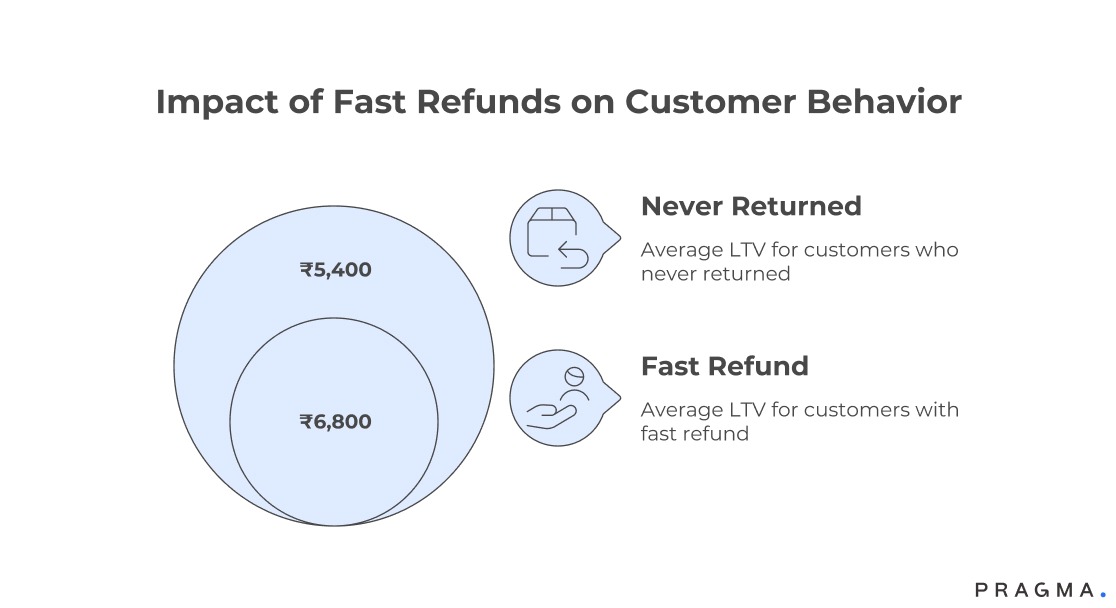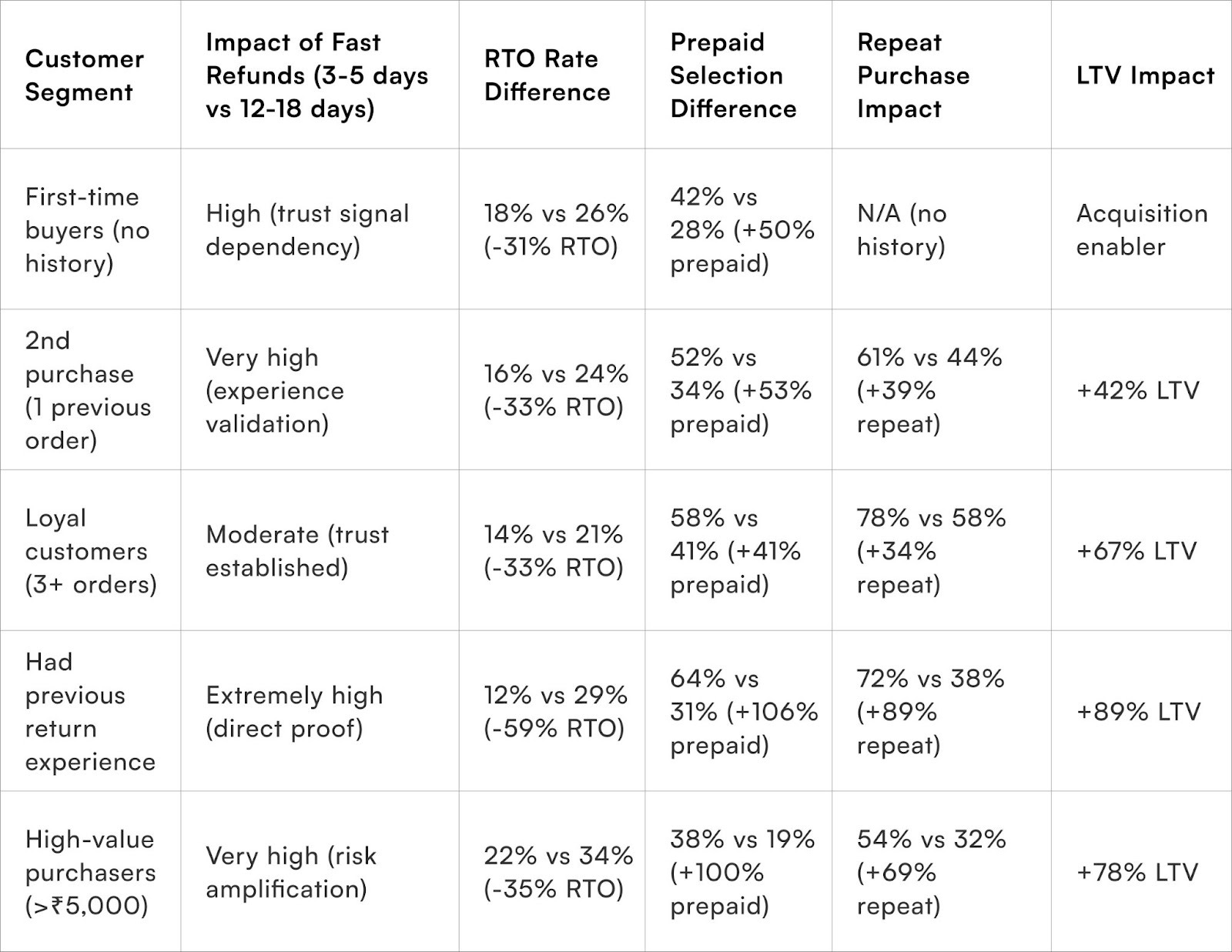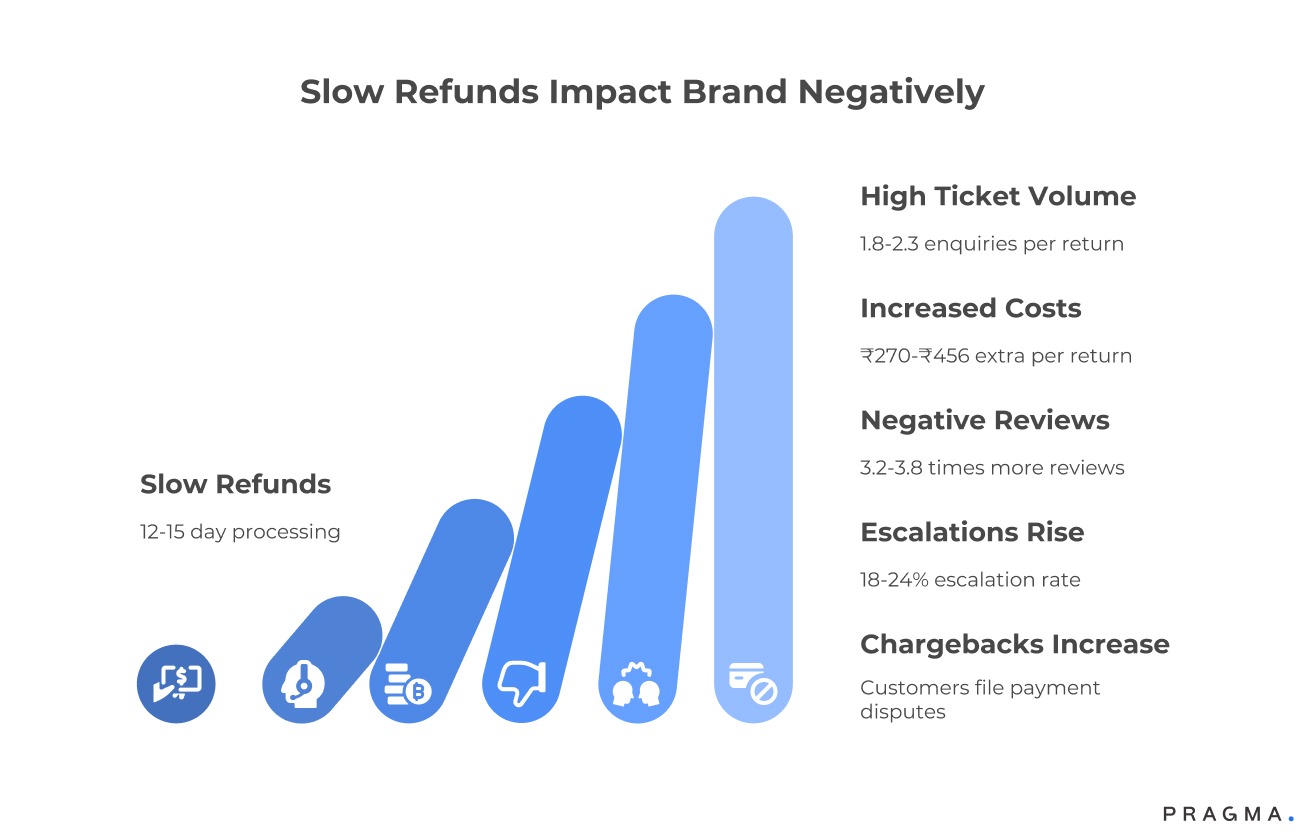Return to Origin (RTO) is still the single biggest operational and profitability challenge for Indian e-commerce and D2C brands—with up to 30-40% of COD orders returning undelivered in some categories, and even top brands battling rates above 20% on their highest-risk segments.
While most RTO discussions focus on
- delivery speed
- address validation
- and payment method nudges
there’s growing evidence that refund experience is just as crucial. Data from 2025’s leading Indian brands reveals that customers who experience swift, hassle-free refunds—especially after a failed delivery or refused COD order—are far less likely to reject future orders, cancel at the door, or perpetuate negative buying behaviours.
Fast refunds build trust, reduce friction, and convert potential detractors into loyal buyers. The operational payoff is substantial: every percentage point improvement in RTO rates translates to lakhs of rupees reclaimed annually, leaner logistics, and improved customer satisfaction.
In today’s margin-sensitive market, speed and transparency in refunds is emerging as a strategic lever—not just for delighting shoppers but for cutting deep into the root causes of expensive RTO trends.
This blog on how Can Faster Refunds Really Reduce RTO Rates? Data from Indian Brands analyses the latest market data and brand case studies,You’ll discover practical strategies and real-world benchmarks that Indian D2C businesses are using right now to capture more margin and build resilient customer trust.
What psychological mechanisms connect refund speed to RTO behaviour?
Customer risk perception shapes payment decisions based on capital opportunity cost expectations

Refund processing timelines influence customer behaviour through financial risk calculation that most brands overlook when treating refunds as isolated operational functions. Customers making purchase decisions evaluate worst-case scenarios where products disappoint and require returns.
Prepaid purchases create immediate capital commitment with uncertain return timelines. Customers considering ₹3,500 orders mentally calculate: "If this doesn't work, my money is locked for how long?"
Brands refunding within 3-5 days present minimal risk—₹3,500 becomes unavailable briefly.
Brands requiring 15-20 days create substantial opportunity cost as that capital could fund alternative purchases or cover unexpected needs during the waiting period.
COD orders eliminate this capital risk entirely by deferring payment until product receipt. Customers can inspect items, verify quality, and reject at delivery without any financial consequence beyond mild inconvenience. This asymmetric risk profile makes COD economically rational for risk-averse customers even when prepaid discounts exist.
Trust formation through refund experiences compounds across customer lifecycles. First-time buyers receiving fast refunds update mental models:
"This brand returns money quickly—prepaid is safe here."
Subsequent purchases shift toward prepaid as perceived risk declines. Conversely, slow refunds create lasting skepticism:
"My money disappeared for 18 days—never doing prepaid again with them."
Market conditioning amplifies individual experiences through word-of-mouth and reviews. Customers mentioning "got refund in 3 days" in reviews signal safety to prospective buyers, whilst complaints about "still waiting 20 days for refund" deter prepaid adoption. These reputation effects multiply beyond individual transaction impacts.
Kolkata fashion brands demonstrate these dynamics quantitatively. After reducing average refund processing from 14 days to 4 days, they tracked subsequent behaviour across 2,400 customers who received refunds.
Customers experiencing fast refunds showed 71% prepaid usage on next purchase compared to 34% prepaid among customers who historically experienced slow refunds. The 37-percentage-point shift in payment preference directly reduced RTO exposure as prepaid orders show 8-12% RTO rates versus 32-38% for COD orders.
How do different refund speeds correlate with measurable RTO changes?
Quantitative analysis across Indian brands reveals specific velocity thresholds generating RTO improvements
Refund speed's impact on RTO (Return to Origin) rates is non-linear, featuring critical thresholds where small improvements yield significant results, making targeted optimisation cost-effective.
Key Findings on Refund Speed and RTO Reduction:
- 15+ days to 7-10 days: Modest RTO reduction (4-8%). This range is appreciated but maintains capital lock-up, sustaining the preference for Cash on Delivery (COD) among risk-averse customers.
- Critical Threshold (3-5 days): RTO reductions increase sharply (15-23%). This speed is perceived as an acceptable risk, encouraging prepaid adoption. It represents a balance between operational feasibility and psychological reassurance, driving a meaningful shift in customer behavior.
- Express Refunds (< 3 days): Additional RTO reduction (8-14%), but with diminishing returns. The benefit of moving from "very fast" (3 days) to "extremely fast" (1 day) is marginal, as baseline speed expectations are already surpassed.
Factors Influencing Benchmarks:
- Regional Variance:
Metropolitan customers (e.g., Bangalore, Mumbai) are sensitive to the 5-day threshold.
Tier-2 customers (e.g., Indore, Vadodara) are satisfied with 7-8 day processing, reflecting lower baseline expectations. Brands should set refund targets based on their customer base composition.
- Category Influence:
High-value items (e.g., electronics, jewellery), typically costing ₹8,000-15,000, show greater sensitivity to refund speed.
Customers purchasing low-value consumables (₹600-1,200) perceive the capital exposure as manageable regardless of the refund timeline.
How does refund speed affect first-time versus repeat customer behaviour?
Trust impact varies by customer familiarity with differential effects on acquisition versus retention
The Compounding Impact of Fast Refunds on RTO Rates and Customer Loyalty
Data from Indian brands reveals that refund speed significantly influences customer behavior, trust, and ultimately, Return to Origin (RTO) rates.
This impact is distinct for new and repeat customers and compounds over the customer lifecycle.

Influence on First-Time Customers (Acquisition & Anxiety Reduction):
- First-time buyers rely heavily on external signals like reviews mentioning refund speed ("got money back in 4 days!").
- Prominently displaying "Fast 3-5 day refunds" messaging improves first-time conversion rates by 12-18% compared to vague "easy returns."
- Specific timing commitments effectively reduce purchase anxiety, especially for customers wary of Cash on Delivery (COD) and the risk of money being tied up in slow return processes.
Impact on Repeat Customers (Trust & RTO Reduction):
- Personal refund experiences create lasting impressions that modify repeat purchase behavior.
- Customers who experience fast refunds show 34-41% higher repeat purchase rates and 28-35% lower RTO rates on subsequent orders than those who endure slow refunds.
- The personal validation ("they actually refunded fast like promised") builds a deeper level of trust than generic positive experiences (e.g., good product, on-time delivery) and continuously influences the decision to accept a delivery.
Correlation with Customer Lifetime Value (LTV):
- Counterintuitively, LTV correlates more strongly with refund speed than with product satisfaction.
- Customers who returned an item but received a fast refund show a higher average LTV (₹6,800) than customers who never returned anything (₹5,400).
- The excellent return-with-fast-refund experience builds brand trustworthiness during a challenging circumstance, effectively converting sceptics into loyal customers—an effect that avoids problems fails to establish.
Compounding Effects Over the Customer Lifecycle (Cohort Analysis):
- The advantage of fast refunds expands with each interaction, demonstrating an accumulation of trust:
- First purchase: Fast refund brands show 15% lower RTO.
- Second purchase: The gap widens to 23% lower RTO.
- Third purchase: The gap reaches 31% lower RTO.
- This expanding delta shows how an initial advantage in refund speed compounds over repeat interactions, creating widening performance gaps between brands with different refund cultures.

What operational systems enable consistent 3-5 day refund processing?
Technical infrastructure and process design determine whether fast refunds represent sustainable operations or unsustainable heroics
Strategies to Accelerate E-commerce Refunds and Reduce RTO Rates
1. Automate Quality Inspection Workflows
Eliminate the 24-72 hour delays caused by manual approval bottlenecks. Implementing automated quality inspection systems with predefined criteria
(e.g., 'unworn with tags: auto-approve,' 'signs of wear: auto-reject') allows for same-day inspection completion for 75-85% of returns.
This automation ensures high throughput while maintaining stringent quality standards, a process impossible to achieve through purely manual review.
- Investment: ₹80,000–150,000 setup for inspection workflow software.
- ROI: Payback typically occurs within 3-4 months through reduced labor costs and faster processing.
2. Integrate Payment Gateway APIs for Programmatic Refunds
Bypass the 1-2 day delay of manual bank transfers or payment portal submissions by integrating directly with payment gateway APIs (e.g., Razorpay, PayU, Cashfree).
This technical integration enables systems to automatically trigger refunds instantly upon quality inspection approval, initiating the transfer in minutes. This method eliminates human intervention delays and minimises errors associated with manual transaction entry.
- Implementation: Requires 2-3 weeks of development work.
- Impact: Permanently transforms refund operations by ensuring speed and accuracy.
3. Implement Next-Day Pickup Scheduling for Reverse Logistics
Compress the return transit time by coordinating priority reverse logistics. Standard courier pickups occurring 3-5 days after a return request automatically delay the start of the refund process.
Offering priority, next-day collection services reduces this initial delay to just 24 hours, enabling refund completion 2-3 days earlier.
While this incurs a small premium, the cost is significantly less than the damage caused by customer dissatisfaction and high RTO rates stemming from slow processing.
- Cost: Express pickup premium is typically ₹15–25 additional per return.
- Benefit: Signals a commitment to the customer that enhances brand perception beyond mere time savings.
4. Provide Real-Time Refund Tracking Visibility
Reduce customer anxiety and build trust by offering automated, real-time status updates at every stage of the refund process
(e.g., "Return received," "Quality check in progress," "Refund approved," "Money transferred").
This transparency transforms the waiting period from an information vacuum—which breeds frustration—into a managed expectation.
Customers are more accepting of realistic timelines when they can see progress, making the perceived refund speed dramatically faster than for brands that lack communication.
- Investment: Minimal, relying on automated messaging systems.
- Outcome: Dramatically improves customer perception of refund speed without necessarily shortening the financial institution's processing time.
How do fast refunds reduce support burden beyond RTO impact?
Refund speed improvements create operational efficiencies extending beyond primary trust benefits
Benefits of Fast Refunds on Operational Efficiency and Brand Reputation

Reduced Support Costs and Volume:
- Support Ticket Volume: A strong correlation exists between refund delays and support ticket volume.
Brands processing refunds quickly (4-5 days) receive only 0.3-0.4 enquiries per return. In contrast, those taking significantly longer (12-15 days) generate 1.8-2.3 enquiries per return, mainly from customers checking status or expressing frustration.
- Cost Savings: With each support interaction costing between ₹180 and ₹240, slow refunds incur an additional cost of ₹270-₹456 per return.
For brands with 500 monthly returns, this difference amounts to ₹1.35-₹2.28 lakhs in extra support expenses.
Enhanced Reputation and Customer Trust:
- Negative Review Prevention: Slow refund processing results in 3.2-3.8 times more negative reviews mentioning refund timing compared to fast processing.
A single negative review (e.g., "took 18 days for refund") can potentially deter 50-80 prospective customers, causing lasting reputational damage that far exceeds the transaction value.
- Positive Trust Signals: Fast refunds mitigate this damage and often generate positive reviews (e.g., "money back in 3 days!") that act as trust signals, attracting new customers.
Decreased Escalation and Dispute Rates:
- Reduced Escalations: Slow refund brands face high customer service escalation rates (manager requests, legal threats, social media complaints) in 18-24% of return cases.
Fast refund brands see a dramatic drop to just 2-4% of cases, which are typically genuine product condition disputes rather than processing delays.
- Management Time Saved: This reduction saves substantial management time and prevents negative interactions that can permanently damage employee morale and customer relationships.
- Lower Chargebacks: Customers are more likely to file payment disputes or bank chargebacks after extended waits, perceiving that the brand is unwilling to refund voluntarily.
Fast refunds prevent these disputes since the money is returned quickly. Dispute resolution is costly, requiring 4-6 hours of staff time per incident, plus potential financial penalties. Fast refunds avoid these costs and maintain positive customer relationships.
Analysing the effectiveness of Faster Refunds
Week 1: Current Refund Timeline Assessment
Track last 100 returns documenting timing at each stage: return request to courier pickup, pickup to warehouse receipt, receipt to quality inspection, inspection to refund approval, approval to bank settlement.
Identify longest delays—often inspection queue (returns sitting 3-5 days before review) and approval processes (waiting 24-48 hours for manager sign-off). Survey customers who returned items asking about refund experience specifically noting whether timing affected their perception or future purchase intent. Calculate current average refund completion time from return request to money in bank.
Expected outcome: Detailed timeline breakdown identifying specific bottlenecks causing delays with quantified understanding of customer sentiment regarding current refund speed.
Week 2: Process Optimisation Implementation
Eliminate manual approval requirements for standard returns under ₹3,000 meeting quality criteria. Shift from weekly batch processing to daily refund initiation reducing average wait by 3-4 days.
Create inspection priority queue ensuring returns receive same-day inspection rather than queuing 2-5 days. Implement a simple spreadsheet tracking system ensuring no return "falls through cracks" waiting indefinitely.
These changes require zero technology investment, only process redesign and staff training.
Expected outcome: Refund timeline reduction from current XX days to 7-9 days through pure process efficiency without technology expenditure, demonstrating feasibility and building case for further investment.
Week 3: Communication Enhancement
Implement automated customer notifications at return milestones even if actual processing hasn't accelerated yet.
Send messages: "Return request received," "Courier pickup scheduled," "Product received at warehouse," "Inspection complete," "Refund processed."
The transparency improves perceived speed even when actual timing unchanged—customers with visibility experience less anxiety.
Add expected timeline communication: "Refunds typically complete within 7-10 days." Create customer-facing tracking page showing return status.
Expected outcome: Improved customer satisfaction with existing refund timing through better communication, reducing support enquiries by 30-40% whilst building foundation for messaging when actual speed improvements deploy.
Week 4: Technology Integration Planning
Research and evaluate refund automation platforms assessing payment gateway API integration options, quality inspection workflow apps, and automated refund processing systems.
Request demos from 3-4 vendors, gathering pricing and implementation timelines. Build business case showing current refund costs (processing time, support burden, RTO impact) versus expected improvements and investment requirements.
Calculate ROI including both direct savings (reduced RTO, lower support costs) and strategic benefits (improved conversion, higher LTV). Present case to leadership securing budget approval for implementation.
Expected outcome: Vendor selected and implementation plan approved with clear business justification enabling technology deployment in subsequent months.
To Wrap It Up
Refund speed functions as a powerful trust signal that customers use evaluating overall brand reliability, directly influencing purchase confidence and delivery acceptance decisions.
The correlation between fast refunds and reduced RTO rates operates through psychological mechanisms—risk perception, reciprocity dynamics, and trust generalisation—that prove more powerful than direct service quality experiences.
Time your next 30 refunds from customer return request through bank settlement, identify your single longest delay stage, then redesign that specific process this week before attempting comprehensive refund transformation.
Sustained refund speed excellence requires treating return processing as strategic customer experience element rather than back-office operational afterthought. Market dynamics shift, customer expectations evolve, and competitive pressures intensify, demanding continuous refinement of refund operations.
Brands establishing monthly refund reviews, analysing processing bottlenecks, testing workflow improvements, and systematically optimising each stage achieve 15-22% additional RTO reduction in year two through accumulated refinements creating customer experiences that slow-refund competitors cannot replicate regardless of product quality or marketing investments.
For D2C brands seeking to leverage refund speed as trust-building mechanism reducing RTO rates, Pragma's return management platform provides automated inspection workflows, payment gateway integration, real-time tracking visibility, and intelligent processing that helps brands achieve 3-5 day refund completion whilst reducing RTO rates by 19-26% through operational excellence demonstrating customer-centricity more credibly than marketing promises ever could.

FAQs (Frequently Asked Questions On Can Faster Refunds Really Reduce RTO Rates? Data from Indian Brands)
1. Won't faster refunds encourage more returns if customers know money comes back quickly?
Data shows opposite effect—fast refunds signal quality confidence, actually reducing frivolous returns.
Customers initiate fewer speculative returns when trusting brands. The 23-29% RTO reduction proves this empirically. Easy, fast refunds remove anxiety barrier to purchases whilst quality products prevent returns regardless of policy generosity.
2. How do we afford fast refunds without destroying cash flow?
Automated systems cost ₹150K-400K setup but process 6,000+ annual returns, amortising to ₹25-65 per return initially, ₹10-15 ongoing.
The investment pays back in 6-9 months through RTO reduction saving ₹180-280 per prevented return. Most brands find improved cash flow from reduced RTO and higher prepaid conversion offset refund speed costs.
3. Should refund speed be same for prepaid and COD orders?
Yes—consistency builds trust. COD refunds taking longer signals second-class treatment for COD customers, increasing their future prepaid preference ironically. Uniform fast refunds across payment methods demonstrate customer-centricity regardless of transaction type. The operational investment benefits all segments creating universal trust improvement.
4. What if quality inspection genuinely requires longer than 3-5 days?
Inspection itself rarely requires extended time—delays come from queue waits. Prioritise return inspection alongside forward fulfilment rather than treating as secondary activity.
For complex items genuinely needing detailed checks (electronics functionality testing), communicate timeline upfront: "Technical products: 5-7 days for thorough testing." Transparency maintains trust even when speed limitations exist.
5. How do we handle refunds when return shipping takes 7-10 days?
Focus on time-in-your-control: same-day inspection and refund initiation upon warehouse receipt. Communicate clearly: "Refund processes within 24 hours of receiving your return."
This positions long timeline as shipping reality (outside your control) versus processing delay (within your control). Consider offering advance refunds on receipt of tracking number for trusted customers
Talk to our experts for a customised solution that can maximise your sales funnel
Book a demo

.png)
.webp)

.png)